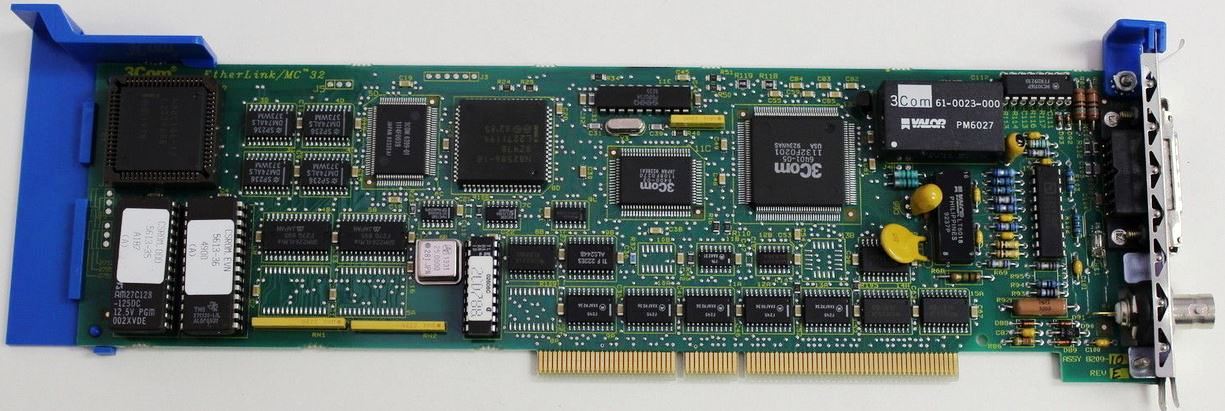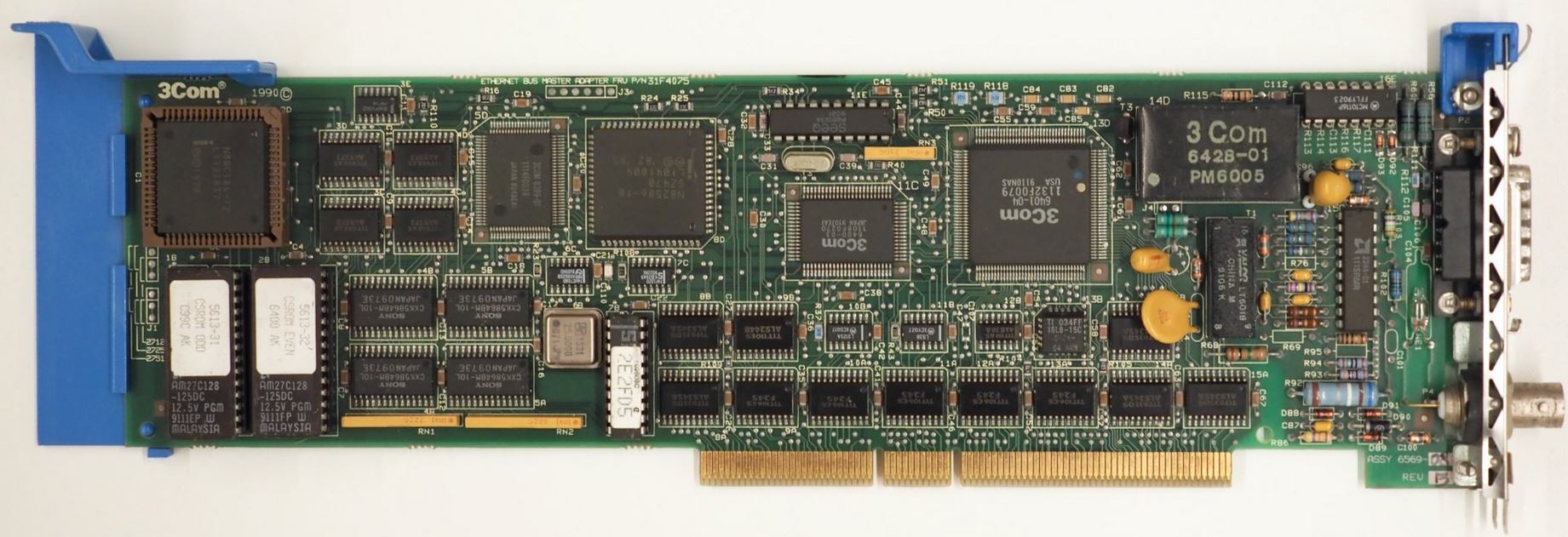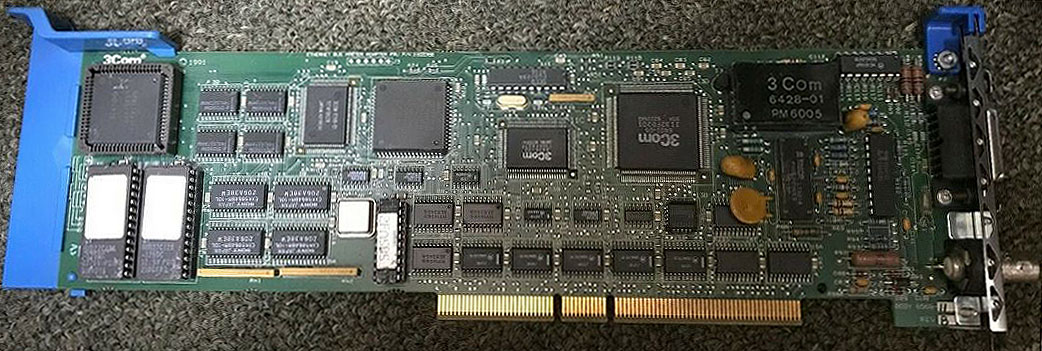|
@0041.ADF - 3Com EtherLink/MC 32 Ethernet Adapter @8EF5.ADF IBM High Performance Ethernet LAN Adapter [Can't Say] NOTE: My SWAG they "Can't Say" this was a re-badged 3C527 [therefor cheaper] BINs for 2-1 [thx to Michal Necasek] 3C527X.EXE V3.3 Etherdisk for Etherlink MC/32 3C527N.EXE E-disk version 3.4, includes NT driver WFW501.EXE 3C501 or 3C527 (self extracting) 3c527 Technical Reference Device Driver Issues in High-Performance Networking [AIX 3.2.5] 3C527 Etherlink/MC32 2-1 [31F4075] [thx to Michal Necasek] 3c527 EPROM and Cache Network Management ROM Format FC 2980 Versions 3C527 EtherLink/MC 32 
1B / 2B 32K microcode, split over two AMD 27C128-125DC 4B/5B 8Kx8 CMOS Static RAM 7B 3Com’s OUI and MAC address 8D 82586 IEEE 802.3 Ethernet LAN Coprocessor 11E SEEQ PQ8023A Manchester Code Converter MCC 16E MC10116P Triple Line Receiver, odd, they used those little press-in pin sockets. Additional Chips on the 2-1 that are not on 3c527 4A/5A CXK5864BM-10L [8,192-Word x 8-BIT High Speed CMOS Static Ram] 8A 74ALS245A Octal transceiver (3-State) 10B LS125A Quad 3-state Buffer 13B 16L8-15C 3E on 81F7913 and 31F4075 74F41 Hex Inverter Schmitt Trigger NOTE: Not used on 00G3368
2-1
[31F4075] Thx to Michal Necasek ! 
After endlessly chanting "Chet Heath" for hours to clear my mind, I noticed the jumper positions to the left of the EPROMs. A bit odd, 3Com never changed the PCB, they just shunted it for a 27128 and called it a day. They could have changed the foil, shunted it internally.\, then drop the [unneeded] silk screening, save a few pennies per card. The three choices are 27128, 27256, 27512 Another brilliant blue flash, the 3c527 has TWO KM6264BL6-10 , 8Kx8 bit Low Power CMOS Static RAM [I think]. The 2-1 has FOUR 8Kx8. I see other artifacts, some SMD LEDs, another set of [empty] jumpers.... Michal Necasek Compares "2-1"
to 3C257 For a moment I was pondering what the big
PROM (32K total) was even for when it’s clearly not a
boot ROM, then realized that it has to be microcode for
the on-board 80186. It certainly contains x86 code.
Interesting adapter. NOTE: the code in
CSAY-O.BIN is not English... ";耒─䕖⁒慃❮⁴慓⁹摁灡整楆" Network Management ROM Access
IBM 2-1: Vital Product Data ROM containing the network
address and revision information. 3Com 3c527: Network
Management ROM, same fields but different field content. Differences Between
EtherLink/MC 32 and IBM 2-1 1. The 2-1's I.D. number is 8EF5, and the 3c527's is
0041.
Uli Link on 2-1 Performance Even on old and slow RS/6000 the 2-1 adapter gives a throughput close to the theoretical maximum of half-duplex 10MBit/s Ethernet with moderate CPU usage. So if the busmaster driver (for PC Operating systems) is written 16MByte RAM ISA busmaster safe the adapter does a fast busmastering into a low mem address buffer and then the CPU copies the data to the destination (a.k.a. double buffering) completely wasting all benefits of busmastering. I once have tested the 2-1 with Novell Netware 3.12 and got very good results. When the drivers was developed such Ethernet cards were connected to hubs and not switches. You don't need to fiddle around with fairness on the Ethernet bus on a switch port. The switch port should generate "collisions" to slow down the port if the destination cannot handle the bandwith at the moment. Those days server adapters were optimized for combined throughput under heavy load on a shared media bus. Programming Form Rick Ekblaw "The interface is pretty simple, commands are mapped to bits and bit groups, there are some command and status registers starting at the I/O base, there are mailboxes and so on. It looks a bit like the Spock interface and a bit like the AHA-154x/164x interface which uses mailboxes" Differences Between 3C527 and 2-1 "The IBM adapter supports exception condition handling such as parity checking/generation, and the EtherLink/MC 32 does not" Drivers for 2-1 UZnal: >The 3C527 and this card are the same thing with different card-IDs. Now I know where I have seen it, I should have a 3C527. But then, the type 2-1 card could be assigned to 0041.ADF renamed to 8EF5.ADF, and the drivers, provided they do not check the adapter ID, work for the type 2-1 card (if not, the adapter ID can be patched in the driver object code). I saw some of the 8EF5 driver code, the POS bytes match the 0041.ADF quite exactly. FC 2980 Versions FRU 81F7913 has P/N 71F1157, 71F1182, 71F1183 - Early versions 71F1182 has the yellow wire rework, a small osc to the right of the 80186, pads for J4 and 5, pins for a jumper under the lower left of the big 3com 6428-01 [14D], J3 populated, populated jumpers for the EPROM size. Note that 71F1183 looses the small osc to the right of the 80186, no yellow wires 71F1182  P/N 31F4073 CE P/N 31F4075 - Intermediate. Needs minimum 3.1.5  FRU 00G3368, P/N 00G3367 - This looks to be the last version  AdapterID 0041 3Com EtherLink/MC 32 Ethernet Adapter Enable/Disable Adapter
I/O Base Address Shared Memory Ranges
Interrupt Level Arbitration Level Fairness Enable Address Burst Management
Transceiver Type |

